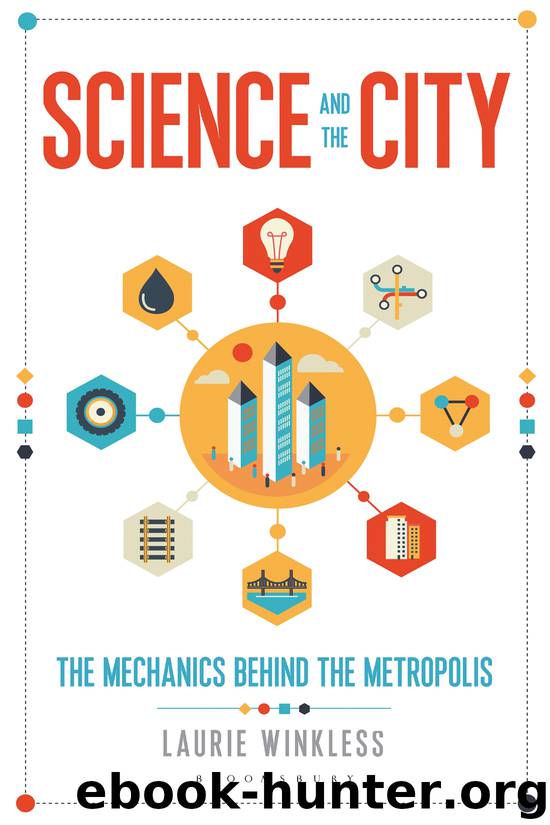Science and the City by Laurie Winkless

Author:Laurie Winkless
Language: eng
Format: epub
Publisher: Bloomsbury Publishing
But for now, I think that’s enough peering into the future. We’ve travelled the length of many urban roads and scaled the heights of iconic bridges. And we’ve met some of those people whose research will transform them all tomorrow. It is time to grab your driving gloves.
1 The CIA World Factbook is maintained online by the Central Intelligence Agency in the US. It aims to ‘marshal facts on every country, dependency, and geographic entity in the world’, and then makes the data publicly available. Am I the only person who’d never heard of it?
2 Dunlop’s patent application was later retracted when it was realised that, unknown to him, another Scotsman, named Robert William Thomson, had registered the same technology almost 40 years earlier. But the latter’s story of discovery has been almost forgotten by history.
3 Increasing friction is why tyres are heavily patterned too – the ridges and channels not only hold onto the road, but they pull water away from the road, further improving the grip.
4 From what I can gather, the terms bitumen, asphalt and pitch are interchangeable and refer to a substance that is naturally occurring. Tar (or coal tar) is produced by the destructive distillation of coal.
5 I’m using the standard Dairy Milk chocolate bar unit of mass measurement here = 45g (1.6oz). Judge me all you want.
6 In Chapter 6, we will head deep under London’s streets to visit some of the most impressive urban tunnels in the world.
7 Everything that’s true for bridges is also true for flyovers and overpasses.
8 This is also true for arched windows and doorways, but instead of the abutments being embedded in the ground, the walls around the frame act as the support.
9 It’s all relative; the suspenders on the Golden Gate Bridge are 68.3mm (211∕16in) in diameter.
10 The 16 original chain cables that Telford used in the Menai Bridge each weighed around 120 tonnes.
11 Resonance wasn’t the only factor at play here – it may have caused some of the initial motion, but it was when cables began to snap that it became self-destructive.
12 As an aside, this oxide is the reason that stainless steel cutlery doesn’t taste metallic when you put it in your mouth. To learn more, I highly recommend Stuff Matters from material scientist and all-round awesome bloke, Mark Miodownik.
13 In 2015 the Bay Bridge team came under fire when advanced corrosion was identified on steel rods connecting the bridge’s tower to its foundation. At the time of writing, $4 million (£2.8 million) had been approved for additional tests and an expert panel from the National Academies of Science and Engineering had been convened to review the work.
14 Yes, these are similar to the dampers used in earthquake-‘proof’ skyscrapers that we covered in Chapter 1.
15 The secondary ‘wave’ that is produced further back along a busy road is called a jamitino – the baby of a jamiton. This has now been added to my list of favourite words.
16 The term jamology was first suggested by Katsuhiro Nishinari of the University of Tokyo.
Download
This site does not store any files on its server. We only index and link to content provided by other sites. Please contact the content providers to delete copyright contents if any and email us, we'll remove relevant links or contents immediately.
| Anthropology | Archaeology |
| Philosophy | Politics & Government |
| Social Sciences | Sociology |
| Women's Studies |
Nudge - Improving Decisions about Health, Wealth, and Happiness by Thaler Sunstein(7655)
iGen by Jean M. Twenge(5384)
The Fire Next Time by James Baldwin(5379)
Adulting by Kelly Williams Brown(4529)
The Sports Rules Book by Human Kinetics(4341)
The Hacking of the American Mind by Robert H. Lustig(4336)
The Ethical Slut by Janet W. Hardy(4211)
Captivate by Vanessa Van Edwards(3814)
Mummy Knew by Lisa James(3653)
In a Sunburned Country by Bill Bryson(3506)
The Worm at the Core by Sheldon Solomon(3450)
Ants Among Elephants by Sujatha Gidla(3440)
The 48 laws of power by Robert Greene & Joost Elffers(3139)
Suicide: A Study in Sociology by Emile Durkheim(2989)
The Slow Fix: Solve Problems, Work Smarter, and Live Better In a World Addicted to Speed by Carl Honore(2975)
The Tipping Point by Malcolm Gladwell(2866)
Humans of New York by Brandon Stanton(2847)
Handbook of Forensic Sociology and Psychology by Stephen J. Morewitz & Mark L. Goldstein(2676)
The Happy Hooker by Xaviera Hollander(2671)
